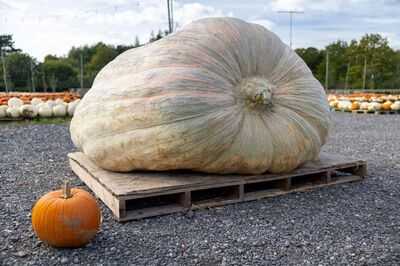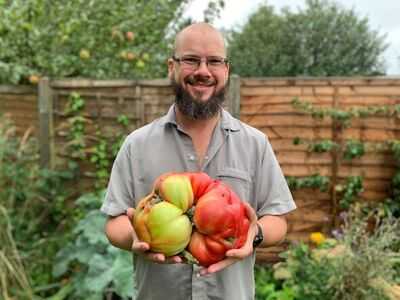In a vast, humid greenhouse on the edge of the New Forest, two men stand in quiet triumph beside a pumpkin so enormous it looks as if it's been plucked from a fairy tale. Its skin is a mottled, sun-warmed orange, its curves so immense that the greenhouse door barely cleared it on the way in. Weighing 2,819 pounds, the equivalent of a small car, it sits on a pallet lined with carpet, like a pampered pet.
This is Muggle, the world's largest pumpkin. And the men beside it, twin brothers Ian and Stuart Paton of Lymington, Hampshire, have just done what no Brit has managed before: they have beaten the Americans at their own oversized game.

"It's taken 50 years," Ian told Daily Express, his voice a mixture of pride and disbelief. "We've had seasons where every pumpkin split. One year we even grew a record-breaker, but there was a tiny hole, and we were disqualified. But this year... well, this year was ours."
At 64, the Paton twins are wiry, weathered men who talk about pumpkins with the kind of reverence poets reserve for love. Their journey began in childhood, when their father ran a flower business from a patch of land behind the family home. "We were always out in the garden," Ian recalls. "One summer, we planted a few pumpkin seeds. We were probably the only kids who wanted to get back from holiday to see how big our pumpkin was. It weighed 56 pounds, we thought it was massive." He chuckles. "And that's how it starts. You catch what we call pumpkin sickness. You're inflicted for life."
The Patons' greenhouse is a cathedral of horticulture. Sunlight streams through high windows and illuminates the dense, curling green of the leaves and vines. Each plant sprawls over 1,200 square feet, roughly the size of a small one-bedroom flat, and drinks up to 130 gallons of water per day. Every vine is buried to encourage extra roots, and each flower is hand-pollinated and covered with care to prevent cross-contamination.
Even with all their careful work, disaster is never far away. "We lost two this year that were even bigger," Ian says. "The sheer weight just pushed down and split them. Heartbreaking. But that's the risk you take when you're trying to grow the biggest fruit ever to sit on the planet."
When asked about the nuts and bolts of growing such giant pumpkins, the brothers are precise and methodical. "It involves a huge amount of water, that's for sure, when they're growing," Ian said.
"They're going to get about 130 gallons of water a day per plant." He emphasises the scale: "Each plant's about 1,200 square feet."
On root development, he is equally specific: "We have to bury all of the sidelines. Because if you bury them and you get it correct, you can end up with an extra root." The flowering stage demands equal care: "It took about two months to get a plant big enough to pollinate. We pollinate very easily. It's important that we pollinate them and cover the flowers to stop them from being cross-pollinated, because these are our future genetics for ourselves and other growers for future years."
They devote six hours a day, every day, to the patch. "You spend six hours a day in that patch, every day, for months," Ian explains.
And if anyone is thinking of starting out, his advice is short and clear: "Start with good genetics. Do lots of homework on the internet." He adds with characteristic pragmatism, "Start with field pumpkins. England has got the absolute perfect conditions for them outside." It is advice born of decades of trial and error, of summers sweating in greenhouses, of nights waking to check on a slowly growing fruit, of watching too many promising pumpkins collapse under their own ambition.
Muggle, this year's champion, grew for 130 days from a seed planted in early April. The Patons name each pumpkin - Hagrid, Dumbledore, Quidditch - with affectionate nods to Harry Potter.
"It keeps things fun," Ian says. "You spend six hours a day in that patch, every day, for months." The effort pays off. When the pumpkin was officially weighed at Wargrave Nursery in Reading last weekend, it tipped the scales at 2,819 pounds and measured more than 21 feet in circumference, overtaking the previous record holder, grown in the US, by 70 pounds.
For a moment, the Paton brothers were speechless. Then came the applause and the cheers. The moment was the culmination of 50 years of persistence, of countless near misses, of seasons spent mourning pumpkins that had split or fallen victim to the weather. "It's not about beating anyone but yourself," Ian says. "It's about the joy of growing and the challenge."
The Patons' love for giant pumpkins is matched by the wider community of growers, a peculiar, passionate, and endlessly generous network of enthusiasts who swap seeds and secrets across allotments and continents.
"We call it the friendliest sport in the world," Ian says. "Everyone helps each other out. We've got a mate in Alaska who grows 2,000-pound pumpkins in a greenhouse buried under 12 feet of snow. You can't get more dedicated than that."
The growers are a mix of retirees, professionals, and full-time gardeners. They are serious about science and soil, yet remain playful and irreverent, often giving their vegetables whimsical names or dressing up for shows.
Among the Patons' friends is Matt Peskett, 48, from Dorking. A web designer by day and pumpkin whisperer by night, Matt stumbled into giant vegetable growing 10 years ago. "I sort of fell into it by accident," he laughs.
"Ten years ago, I got an allotment, accidentally grew a big pumpkin. Well, I thought it was big, but then I went to RHS London and I realised it wasn't big when I came across these pumpkins that were 1000 pounds or 1500 pound pumpkins. I thought, 'I've got to have some of that'.
Matt's efforts have turned him into a local celebrity. The town's annual pumpkin show is part harvest festival, part carnival, with costumes, themed displays, and occasional fantasy flourishes.
"In 2022, we did Gourd of the Rings," he recalls. "I dressed up as Gandalf and stood in the back of a pickup truck with my 677-pound pumpkin. It caused quite a stir in the high street." For Matt, horticulture has been therapeutic. After a cancer diagnosis last year, he found solace in the simple act of tending his allotment.
"Horticulture's the best therapy there is," he says. "When you plant something, you're thinking about the future. You're nurturing life. It keeps you moving forward."

Further north in Norfolk, Douglas Smith, 47, has carved out his own niche in the giant vegetable world, holding European records for the heaviest tomato, 4.39 kilos, and largest cantaloupe, 27.6 kilos. A product manager by trade, Douglas spends his free time coaxing oversized vegetables from rich East Anglian soil.
"I started about a decade ago after seeing those massive American pumpkins," he says. "I thought, 'Why not give it a go?' Next thing I knew, I was growing a tomato the size of a newborn baby." Douglas's land is a laboratory and playground rolled into one.
"I grew a sunflower with my 10-year-old son that went over the roof of the house," he says. "It didn't break any records, but it was pure joy."
Douglas is deeply embedded in a global network of growers. "It's a close-knit community," he says. "We even have team competitions. I'm in one called The Lads from Blighty. This year, we're going for the biggest tomato. It's competitive, but all in good humour. When someone breaks a record, we all celebrate."
For all these growers, giant vegetables are as much about community and joy as size and weight. The process demands patience, endurance, and a willingness to learn from mistakes.
It requires attention to detail, a steady hand, and a good sense of humour when pumpkins crack under their own weight or a storm rages through. It's a hobby that rewards persistence, curiosity, and a love for the absurd.
Back in their greenhouse, Muggle sits quietly on its pallet, sunlight sliding across its gleaming orange skin. The Paton twins hover nearby, already talking about next year's seeds and the next challenge.
"I'm not retiring," Ian says with a grin. "Not yet. We've hit 2,819 pounds, now I want to see a 3,000-pound pumpkin."
The latest edition of Guinness World Records 2026 celebrates the most astonishing vegetable achievements. From record-breaking pumpkins to towering pea plants, these growers have pushed the limits of what our gardens can produce. Here are the year's world record-holders who are based in the UK:
- Peter Glazebrook - Heaviest potato (4.98 kg); Longest runner bean (89.7 cm); Longest leek (1.582 m); Heaviest sunflower head (7.046 kg)
- Ian Neale - Heaviest bell pepper (966 g)
- Curtis Leach - Heaviest celeriac (6.6 kg)
- Vincent Sjodin - Heaviest cucumber (13.388 kg)
- Chris Marriott - Heaviest kohlrabi (47 kg)
- Gareth Griffin - Heaviest onion (8.97 kg)
- Chris Evans - Heaviest red cabbage (33 kg)
- Martin Enstone - Heaviest runner bean (254 g)
- Joe Atherton - Longest beetroot (8.56 m); Longest carrot (6.245 m); Longest luffa (1.296 m); Longest parsnip (6.55 m); Longest radish (7.401 m); Longest turnip (4.842 m); Longest salsify (5.57 m)
- James Brown - Longest broad bean (45.5 cm)
- Sebastian Suski - Longest cucumber (113.4 cm)
- Douglas Smith - Tallest pea plant (4.74 m); Tallest tomatillo plant (4.26 m)
All of these incredible feats are featured in this year's edition of GWR2026, showcasing the world's most remarkable growers and their oversized vegetables.
You may also like

Gaza crackdown: Hamas posts video of public execution of 'collaborators and outlaws'; 4 hostages' remains return to Israel

PM Modi expresses grief over Jaisalmer bus fire tragedy; announces ex-gratia of Rs 2 lakh for kin of deceased

'Spent a decade but can't speak English': Indian-origin truck driver's interview goes viral, Social media users ask why he is seeking asylum in US

GB News star Peter Whittle reveals tragic stage four cancer diagnosis

George Russell's demand to Ted Kravitz to break rules before 'starting explosive fight'






